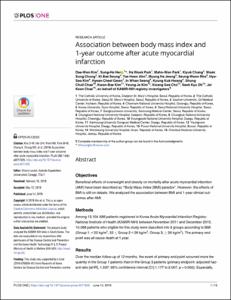KUMEL Repository
1. Journal Papers (연구논문)
1. School of Medicine (의과대학)
Dept. of Internal Medicine (내과학)
Association between body mass index and 1-year outcome after acute myocardial infarction
- Keimyung Author(s)
- Kim, Kwon Bae
- Department
- Dept. of Internal Medicine (내과학)
- Journal Title
- PLoS One
- Issued Date
- 2019
- Volume
- 14
- Issue
- 6
- Abstract
- Objectives:
Beneficial effects of overweight and obesity on mortality after acute myocardial infarction (AMI) have been described as “Body Mass Index (BMI) paradox”. However, the effects of BMI is still on debate. We analyzed the association between BMI and 1-year clinical outcomes after AMI.
Methods:
Among 13,104 AMI patients registered in Korea Acute Myocardial Infarction Registry-National Institute of Health (KAMIR-NIH) between November 2011 and December 2015, 10,568 patients who eligible for this study were classified into 3 groups according to BMI (Group 1; < 22 kg/m2, 22 ≤ Group 2 < 26 kg/m2, Group 3; ≥ 26 kg/m2). The primary end point was all cause death at 1 year.
Results:
Over the median follow-up of 12 months, the event of primary end point occurred more frequently in the Group 1 patients than in the Group 3 patients (primary endpoint: adjusted hazard ratio [aHR], 1.537; 95% confidence interval [CI] 1.177 to 2.007, p = 0.002). Especially, cardiac death played a major role in this effect (aHR, 1.548; 95% confidence interval [CI] 1.128 to 2.124, p = 0.007).
Conclusions:
Higher BMI appeared to be good prognostic factor on 1-year all cause death after AMI. This result suggests that higher BMI or obesity might confer a protective advantage over the life-quality after AMI.
- Keimyung Author(s)(Kor)
- 김권배
- Publisher
- School of Medicine (의과대학)
- Citation
- Dae-Won Kim et al. (2019). Association between body mass index and 1-year outcome after acute myocardial infarction. PLoS One, 14(6), e0217525–e0217525. doi: 10.1371/journal.pone.0217525
- Type
- Article
- ISSN
- 1932-6203
- Source
- https://journals.plos.org/plosone/article?id=10.1371/journal.pone.0217525
- Appears in Collections:
- 1. School of Medicine (의과대학) > Dept. of Internal Medicine (내과학)
- 파일 목록
-
-
Download
 oak-2019-0160.pdf
기타 데이터 / 1.31 MB / Adobe PDF
oak-2019-0160.pdf
기타 데이터 / 1.31 MB / Adobe PDF
-
Items in Repository are protected by copyright, with all rights reserved, unless otherwise indicated.